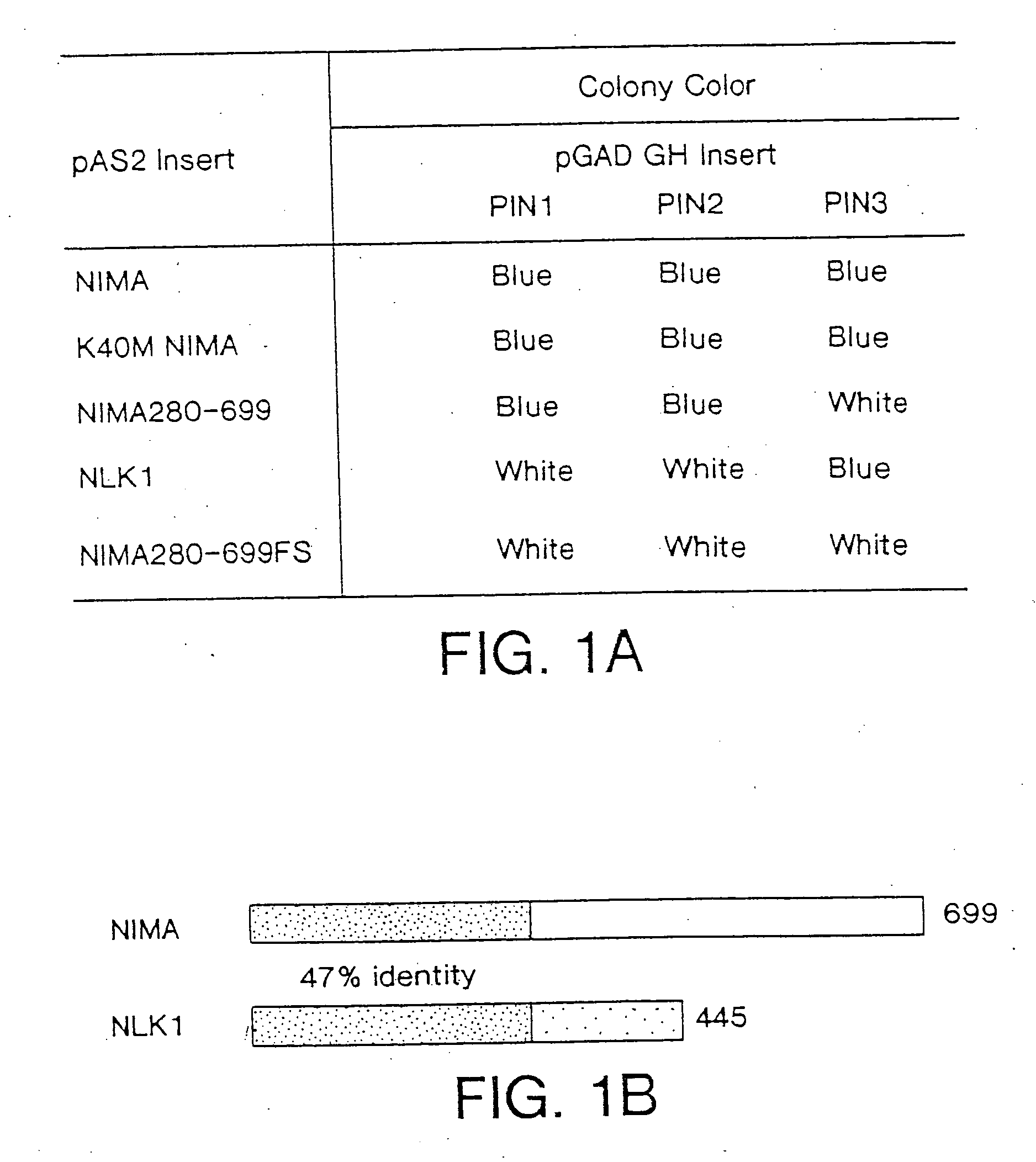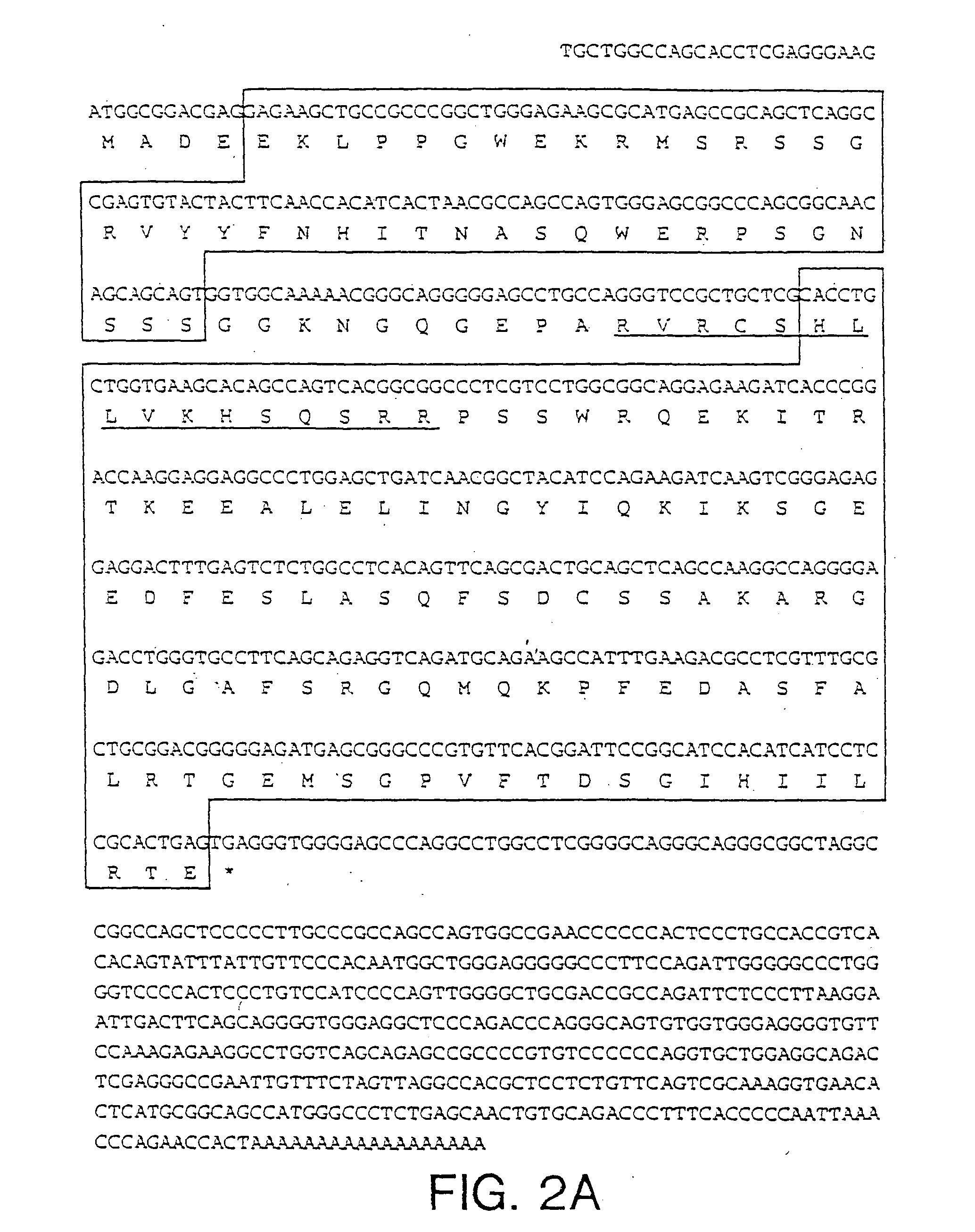NIMA interacting proteins
a technology of nima and kinase, which is applied in the field of eukaryotic cell cycle, can solve the problems that the activation of cdc2 kinase itself is not sufficient to trigger mitosis, and achieve the effect of inhibiting the mitosis-promoting function of nima protein kinase, increasing pin1 activity, and increasing pin1 expression
- Summary
- Abstract
- Description
- Claims
- Application Information
AI Technical Summary
Problems solved by technology
Method used
Image
Examples
example 1
Materials and Methods
[0084] 1. Yeast Two-Hybrid Screen and cDNA Isolation
[0085] For the yeast two-hybrid screen, the Aspergillus nidulans nimA cDNA was inserted into the pAS2 vector (from S. Elledge; HHMI, Baylor University)(Durfee et al., 1993; Harper, et al., 1993) as fusion to GAL4 DNA-binding domain, resulting in NIMA / PAS2. A HeLa cell two-hybrid cDNA library that contained inserts fused to the transactivation domain of GAL4 (residue 768-881) (obtained from D. Beach; HHMI, Cold Spring Harbor Laboratory, New York Nov. 12, 1995) (Hannon et al., 1993) was contransformed with NIMA / PAS2 into the yeast reporter strain Y190, which was then plated on yeast drop-out media lacking Leu, Trp and His containing 35 mM 3-amino-1,2,4-triazole and about 106 transformants were analyzed as described previously (Harper et al., 1993). To determine the interaction properties of isolated clones. K40M NIMA, NIMA280-699, NLK1 and a frame-shift mutant NIMA280-699FS (a base pair deletion at the litigati...
example 2
Identification of Clones Encoding Proteins Interacting with NIMA (PINS)
[0106] To search for human cDNAs encoding proteins able to interact with NIMA, a yeast two-hybrid system that uses GAL4 recognition sites to regulate expression of both HIS3 and LacZ (Durfee et al., Genes Dev., 7:555, 1993) was used. As bait, the full length coding sequence of the Aspergillus nidulans nimA was fused to the C-terminus of the GAL4 DNA-binding domain in pAS2 driven by a partially ADH promoter (Harper, et al., Cell, 75:805, 1993). As prey, we used the GAL4 transactivation domain and a human HeLa cell cDNA fusion library driven by the highly active entire ADH promoter, resulting in high level expression (Hannon, et al., Genes Dev., 2378, 1993). Initially, Y190 cells were transformed with the NIMA / pAS2 expression vector in an attempt to establish stable strains constitutively expressing NIMA, but the transformant colonies were very small and could not be propagated. The failure of the transformants to...
example 3
Analysis of the PIN1 cDNA
[0108] The DNA and deduced amino acid sequence of the protein encoded by the longest PIN1 cDNA (1.0 kb) is shown in FIG. 2A. It encodes a protein of 163 amino acids with the predicted molecular weight of 18,245. When expressed in HeLa cells, Pin1 migrated with an apparent size of −18 kDa in an SDS-polyacrylamide gel. Pin1 shows a high similarity to the budding yeast Ess1 protein (Hanes et al., Yeast. 5:55, 1989). Based on recent RNA primer-extension studies and reexamination of the nucleotide sequence of ESS1 (Hani et al., FEBS Lett., 365:198, 1995), it is likely that the second ATG is used as the initiation codon, rather than the first ATG as originally proposed (Hanes et al., Yeast, 5:55, 1989); in addition, a G should be inserted at position 919, which results in a C-terminal frame shift. The corrected ESS1 sequence encodes a 169 amino acid protein with 45% identity to Pin1. Northern blot analysis of human cell line and human fetal liver RNAs showed that...
PUM
| Property | Measurement | Unit |
|---|---|---|
| concentrations | aaaaa | aaaaa |
| time | aaaaa | aaaaa |
| β-Galactosidase Activity | aaaaa | aaaaa |
Abstract
Description
Claims
Application Information
 Login to View More
Login to View More - R&D
- Intellectual Property
- Life Sciences
- Materials
- Tech Scout
- Unparalleled Data Quality
- Higher Quality Content
- 60% Fewer Hallucinations
Browse by: Latest US Patents, China's latest patents, Technical Efficacy Thesaurus, Application Domain, Technology Topic, Popular Technical Reports.
© 2025 PatSnap. All rights reserved.Legal|Privacy policy|Modern Slavery Act Transparency Statement|Sitemap|About US| Contact US: help@patsnap.com



